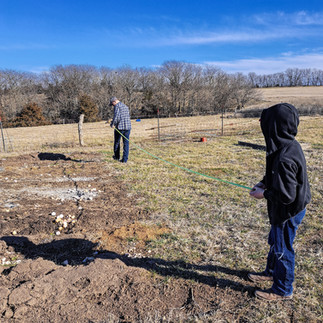How to Plan Your Garden
- Kelsey

- Feb 21, 2024
- 3 min read


Before you plant your garden, you should PLAN your garden!
Is it absolutely necessary to make a plan? We think so! Making a plan helps you to see what you have right in front of you on a smaller scale before you get everything in the ground. We find having a plan makes the planting part go so much smoother. Here are a few reasons why a plan is beneficial:
Know What Kind of Seed You Need
Having an idea of what you're wanting to plant will help you determine which seed to buy. Also, determine whether you're going to plant directly into the soil, or if you're going to start your own Spring veggies from seed ahead of time.
Know the Quantity of Seed
Knowing how much of everything you need helps a TON when it comes to planting, mostly so you don't cut yourself short or end up with way more than you need. If you do end up with extra seed after planting, sometimes it will keep until the next year if stored in a cool, dry location. It is a good idea to check the germination before planting seed from a prior year.
Leave Appropriate Distances
When planting a garden, it's not an "all at once" thing where you plant everything at the same time, like red potatoes and tomatoes. Typically, you'll have a cold crop (late Winter/early Spring) of veggies that tolerate the colder temperatures, and then a Spring-Summer crop for the rest that thrive in a warmer environment.
You don't want to fill the entire garden up with the cold crop, and then get to the point where you're ready to plant your Spring crop and don't have enough space in your garden, so mapping it out on a smaller scale will help you determine if there is enough space for what you're wanting to grow.
How do you make a plan?
Measure your garden dimensions, then draw a smaller scale model of your garden.
With a tape measure, find the length and width of your garden in feet. On a piece of graph paper, count the squares and determine the necessary length for each square. You can do something like 1 square = 1 foot, 1 square = 2 feet, etc. (We made this printable download as an example if you don't have any graph paper on hand!)
(Click the image to download the PDF!)

Determine how far apart you want rows planted.
Depending on what you're growing, some things can be planted closer together, while others need a bit more space. Potatoes need room under the ground to root out, while peas can be in a much closer proximity.
Label the rows with the items you want to plant.
Map out where you want everything! Smaller things like radishes, lettuce, and spinach can be planted next to each other on the same row. For example, you may not want a full row of radishes. In 1 row, you can do 15 feet of radishes, and plant lettuce or spinach for the remainder of that row. Other items like potatoes, beets, peas, or beans might need more than one row. Once you get one year under your belt, you can learn what works for the space you have and what you need to do differently.

For example: our garden was 35'×40'.
On a piece of graph paper, we counted the squares and determined the necessary length for each square (i.e. 1 square = 2.5 feet)
We drew borders and labeled which side is North.
Finally, we marked (you can also color) and labeled rows with the items we will plant and where.
If you aren't sure where to start, check out our other posts in the gardening category! We give you more information on when to plant what, how far apart to plant each item, and when to know your vegetables are ready to harvest!


















Comments